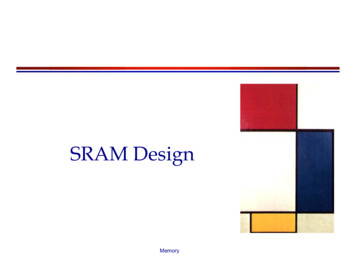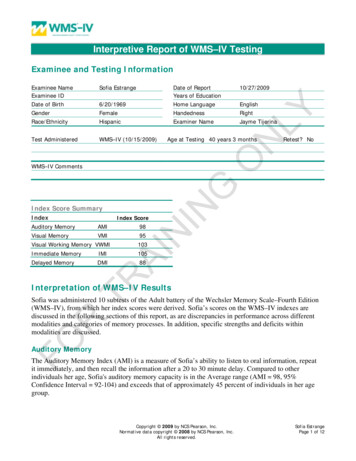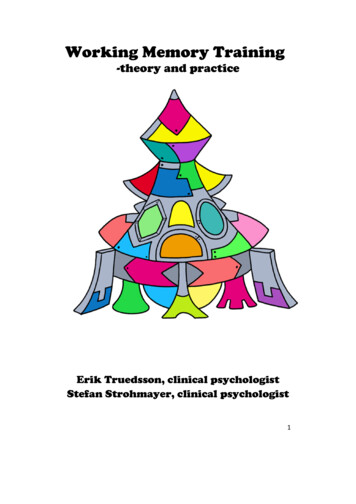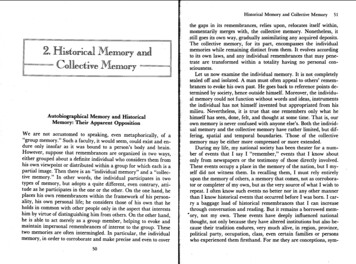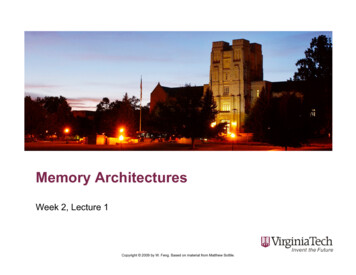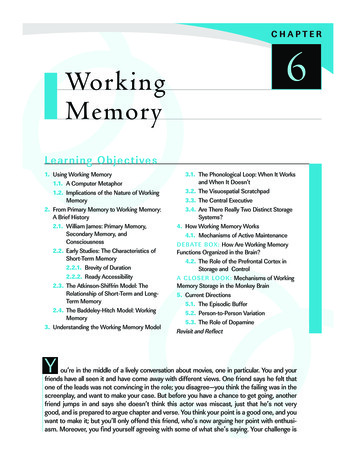
Transcription
CHAPTERWorkingMemory6L ea rn i n g O bj e c t i ves1. Using Working Memory1.1. A Computer Metaphor1.2. Implications of the Nature of WorkingMemory2. From Primary Memory to Working Memory:A Brief History2.1. William James: Primary Memory,Secondary Memory, andConsciousness2.2. Early Studies: The Characteristics ofShort-Term Memory2.2.1. Brevity of Duration2.2.2. Ready Accessibility2.3. The Atkinson-Shiffrin Model: TheRelationship of Short-Term and LongTerm Memory2.4. The Baddeley-Hitch Model: WorkingMemory3. Understanding the Working Memory Model3.1. The Phonological Loop: When It Worksand When It Doesn’t3.2. The Visuospatial Scratchpad3.3. The Central Executive3.4. Are There Really Two Distinct StorageSystems?4. How Working Memory Works4.1. Mechanisms of Active MaintenanceDEBATE BOX: How Are Working MemoryFunctions Organized in the Brain?4.2. The Role of the Prefrontal Cortex inStorage and ControlA CLO SE R LO O K: Mechanisms of WorkingMemory Storage in the Monkey Brain5. Current Directions5.1. The Episodic Buffer5.2. Person-to-Person Variation5.3. The Role of DopamineRevisit and ReflectYou’re in the middle of a lively conversation about movies, one in particular. You and yourfriends have all seen it and have come away with different views. One friend says he felt thatone of the leads was not convincing in the role; you disagree—you think the failing was in thescreenplay, and want to make your case. But before you have a chance to get going, anotherfriend jumps in and says she doesn’t think this actor was miscast, just that he’s not verygood, and is prepared to argue chapter and verse. You think your point is a good one, and youwant to make it; but you’ll only offend this friend, who’s now arguing her point with enthusiasm. Moreover, you find yourself agreeing with some of what she’s saying. Your challenge is239
240CHAPTER 6Working Memoryto manage two tasks at once: pay attention to what your friend is saying, both out of courtesyand to follow her argument so you don’t repeat or overlook her points when you speak; andhold on to your own argument, which is forming in your head as you listen. Your working memory is getting a workout!Working memory is widely thought to be one of the most important mental faculties,critical for cognitive abilities such as planning, problem solving, and reasoning. This chapterdescribes current conceptions regarding the nature of working memory, its internal components, and the way it works. We specifically address five questions:1.2.3.4.5.How is working memory used in cognition?How did the modern view of working memory arise?What are the elements of working memory?How does working memory “work” in the brain?How might views of working memory change in the future?1. USING WORKING MEMORYEvery day we have occasion to keep particular pieces of critical information brieflyin mind, storing them until the opportunity to use them arrives. Here are some examples: remembering a phone number between the time of hearing it and dialing it(“1 646 766-6358”); figuring a tip (the bill is 28.37, call it 30; 10 percent of thatis 3.00, half of that is 1.50, 3.00 plus 1.50 is 4.50, the 15 percent you’re aiming for); holding driving directions in mind until you get to the landmarks you’vebeen told to watch for (“take the first left, continue for one mile, past the school,bear right, left at the four-way intersection, then it’s the third building on the left—you can pull into the driveway”). Sometimes a problem offers multiple possible solutions, such as when you must look ahead along various possible sequences ofmoves in a chess game, and sometimes, as when you must untangle the structure ofa complex sentence like this one, it is straightforward but nonetheless requires holding bits of information in mind until you can put it all together.In situations like these, not only do we need to keep certain bits of information accessible in mind, but also we need to perform cognitive operations on them, mullingthem over, manipulating or transforming them. These short-term mental storage andmanipulation operations are collectively called working memory. Think of workingmemory as involving a mental blackboard—that is, as a workspace that provides atemporary holding store so that relevant information is highly accessible and availablefor inspection and computation. When cognitive tasks are accomplished, the information can be easily erased, and the process can begin again with other information.1.1. A Computer MetaphorThe computer, so useful a metaphor in cognitive psychology, offers an intuitivelyappealing model for thinking about the nature and structure of working memory.
REVISED PAGES1. Using Working MemorySimplifying the workings of a computer, there are two means by which information is stored, the hard disk and random-access memory (RAM). The hard disk isthe means by which information is stored permanently in a stable and reliableform; all software programs, data files, and the operating system of the computerare stored on the hard disk. To use this stored information you must retrieve itfrom the hard disk and load it into RAM. Now for the analogy: the informationstored in the hard disk is like long-term memory, RAM corresponds to workingmemory.The notion of working memory as a temporary workspace fits nicely: in a computer, RAM is cleared and reset when the task executed by the program is finished,or when the program is closed. The computer metaphor also suggests two furthercharacteristics of working memory. First, RAM is completely flexible with regard tocontent. That is, there is no fixed mapping between the location of a part of RAMand the program that uses it; any program can access any part of RAM. Second, themore RAM a computer has, the more complex and sophisticated the programs thatcan be run on it, and the more programs that can be running simultaneously. Thus,if the computer-based metaphor of working memory holds, storage in workingmemory involves a content-free flexible buffer (the term in computer science for alimited-capacity memory store), and cognitive abilities are dependent on the size ofthe buffer.How well does this metaphor fit with actual human working memory structureand function? The evidence is not all in, but cognitive and neuroscience approachesto the study of working memory have in many ways revolutionized the types ofquestions that can be asked and provided new insights into how working memoryworks.1.2. Implications of the Nature of Working MemoryA better understanding of the nature of human working memory may have important implications for understanding why people differ in cognitive skills and abilitiesand why individuals have different degrees of success in their efforts to accomplishreal-world goals. Research suggests that people vary widely in working memory capacity (also known as working memory span), the amount of information that canbe held accessible (Daneman & Carpenter, 1980), and that these differences predictgeneral intelligence (as measured by standard IQ tests), verbal SAT scores, and eventhe speed with which a skill such as computer programming is acquired (Kane &Engle, 2002; Kyllonen & Christal, 1990).A test to determine working memory capacity is shown in Figure 6–1. (Why nottake it yourself? Do the results accord with your view of your own working memory?) A relationship between working memory and cognitive ability is not surprising,given how pervasively working memory affects a wide range of complex cognitivetasks, not all of them as mundane as figuring out a tip. The more interesting questionsremain: why do people differ so widely in working memory capacity, and where exactly do the differences lie? If we understood more precisely the components ofworking memory, and which aspects are the most critical for real-world cognitive241
SMITMC06 0131825089.QXD 3/28/06 6:57 AM Page 242242CHAPTER 6ISISISISISISREVISED PAGESWorking Memory(5 ! 3) " 4 # 17?(6 ! 2) 3 # 8?(4 ! 4) 4 # 12?(3 ! 7) " 6 # 27?(4 ! 8) 2 # 31?(9 ! 2) " 6 # 24?FIGURE 6–1BOOKHOUSEJACKETCATPENWATERA standard test of working memory capacityTo take this test yourself, cut out a window in a blank sheet of paper so that it exposes only one lineat a time. For each line, determine whether the arithmetic is correct or not: say, out loud, “yes” or“no.” Then look at the word that follows the problem and memorize it. Move through each line quickly.After you have finished all the lines, try to recall the words in order. The number you get correct isan estimate of your working memory capacity. Very few people have a working memory as high as 6;the average is around 2 or 3.success, we might be able to develop methods to train and exercise working memoryin a manner that could improve its function, and consequently enhance a person’scognitive repertoire.Today’s conceptions of working memory have evolved from earlier ideas in cognitive psychology, and current research stands, as so often in science, on the shoulders of predecessors. What the earliest workers did not have were the tools providedby modern neuroscience. Nonetheless, their work is a good place to begin.! Comprehension Check:1. Give an example of an everyday situation in which you would need to use working memory.2. If working memory were a capacity of a computer, what component might itcorrespond to, and why?2. FROM PRIMARY MEMORY TO WORKING MEMORY:A BRIEF HISTORYThe notion that there is a distinct form of memory that stores information temporarily in the service of ongoing cognition is not new, but ideas regarding thenature and function of short-term storage have evolved considerably during the
SMITMC06 0131825089.QXD 3/28/06 6:57 AM Page 243REVISED PAGES2. From Primary Memory to Working Memory: A Brief Historylast hundred years. The very terms for this storage system have changed over theyears, from primary memory to short-term memory to working memory. Howand why did this happen?2.1. William James: Primary Memory, Secondary Memory,and ConsciousnessThe first discussion of a distinction between short-term and long-term storage systems was put forth by the pioneering American psychologist William James in thelate nineteenth century. James called these two forms of memory primary memoryand secondary memory, using these terms to indicate the degree of the relationshipof the stored information to consciousness (James, 1890). In James’s view, primarymemory is the initial repository in which information can be stored and made available to conscious inspection, attention, and introspection. In this way, such information would be continually accessible. In James’s words, “an object of primarymemory is thus not brought back; it never was lost.” He contrasted primary memory with a long-term storage system, or secondary memory, from which information cannot be retrieved without initiating an active cognitive process. The linkbetween working memory and consciousness that James sought to describe remainsa central part of most current thinking; the question of whether or not we are conscious of the entire contents of working memory is still open to debate. Some currentmodels suggest that only a subset of working memory is consciously experienced(Cowan, 1995).2.2. Early Studies: The Characteristics of Short-Term MemoryDespite James’s early work regarding the system for short-term information storage,there were no experimental studies of the characteristics of this system until the1950s. Part of the reason for this neglect was the dominance of behaviorist views inthe first half of the twentieth century, which shifted the focus of investigation awayfrom cognitive studies. Then George Miller, an early and influential cognitive theorist, provided detailed evidence that the capacity for short-term information storageis limited. In what has to be one of the most provocative opening paragraphs of acognitive psychology paper, Miller declared: “My problem is that I have been persecuted by an integer. . . . [T]his number has followed me around, has intruded in mymost private data, and has assaulted me from the pages of our most public journals.This number assumes a variety of disguises, being sometimes a little larger and sometimes a little smaller than usual, but never changing so much as to be unrecognizable” (Miller, 1956, p. 81). In this paper, titled “The Magical Number Seven, Plus orMinus Two,” Miller suggested that people can keep only about seven items active inshort-term storage, and that this limitation influences performance on a wide rangeof mental tasks.What data supported Miller’s claim? Tests of short-term memorization, such asrepeating a series of digits, showed that regardless of how long the series is, correctrecall of digits appears to plateau at about seven items (though for some people this243
244CHAPTER 6Working Memoryplateau number is a little lower and for some it is a little higher; Guildford &Dallenbach, 1925). Miller made a further, and critical, point: that although there isa limitation on the number of items that can be simultaneously held in short-termstorage, the definition of an “item” is highly flexible, and subject to manipulation.Specifically, Miller (1956) suggested that single items can be grouped into higherlevel units of organization he called chunks. Thus, three single digits could bechunked together into one three-digit unit: 3 1 4 becomes 314. What determineshow much information can be chunked together? Miller suggested that chunkingmight be governed by meaningfulness. For example, if the numbers 3 1 4 are yourarea code, it is a very natural process to store them together as a chunk. Thesegrouping processes seem to be ubiquitous in language, where we effortlessly groupletters into word-chunks and words into phrase-chunks. Indeed, this may be whyour ability to maintain verbal information in short-term storage is better than forother types of information.The key notion of Miller’s chunk idea is that short-term storage, though possibly subject to certain constraints, is not rigid but amenable to strategies, such aschunking, that can expand its capacity. This notion is still very much present in current thinking about working memory. However, although the notion of a “magicalnumber” is still part of current ideas regarding short-term storage capacity, recentwork has suggested that this number might not actually be 7 ! 2, as Miller suggested, but instead may be much less—3 ! 1. This revised estimate comes from areview of studies suggesting that storage capacity is much lower than seven whenparticipants are prevented from using strategies such as chunking or rehearsal(Cowan, 2001).Miller’s (1956) work drew attention to the concept of short-term storage and itsfunctional characteristics. However, other influential evidence suggesting the distinctnature of the short-term storage system came from studies of amnesics who, likeH.M. (see Chapter 5), showed grossly impaired long-term memory but relatively intact performance on immediate recall tasks (Baddeley & Warrington, 1970; Scoville& Milner, 1957). As a result, a common view emerged that short-term storage wasstructurally and functionally distinct from long-term storage and could be independently studied. In particular, it seemed that short-term memory, as this capacitybegan to be called, could be uniquely defined in terms of its short duration and highlevel of accessibility. During the 1950s and 1960s much research was devoted toexamining these characteristics.2.2.1. Brevity of DurationA central idea regarding short-term memory was that information would be available only for a very brief period if it were not rehearsed. An experimental techniquefor studying short-term memory called the Brown-Peterson task was developed totest that idea (Brown, 1958; Peterson & Peterson, 1959). Participants are typicallygiven a string of three consonants to memorize and then prevented from engaging inactive rehearsal (that is, from saying the consonants to themselves), perhaps by being asked to count from 100 backward by 3s. After variously set delays, participantswould be asked to recall the string. Measuring recall accuracy in relation to the delay
SMITMC06 0131825089.QXD 3/28/06 6:57 AM Page 245REVISED PAGES2. From Primary Memory to Working Memory: A Brief History100Accuracy of recall (%)806040200369121518Recall interval (sec)FIGURE 6–2Short-term recall related to delay interval in the Brown-Peterson taskTypically, accuracy in recalling short consonant strings decays to about 50 percent by 6 seconds andalmost to zero by 18 seconds if rehearsal is blocked.(Peterson, L. R., and Peterson, M. J. (1959). Short-term retention of individual verbal items. Journal of ExperimentalPsychology, 58, 193–198, Fig. 3, p. 195 [adapted].)interval showed the time course of forgetting. After a delay as short as 6 seconds, recall accuracy declined to about 50 percent, and by about 18 seconds recall was closeto zero (Figure 6–2). These findings suggested the shortness of short-term storage.(About this time investigations were also being conducted on an even briefer form ofstorage—termed sensory memory—that serves to keep a perceptual representationof a stimulus persisting for a few hundred milliseconds after the sensory input isgone; Sperling, 1960.)However, in work that followed, a controversy arose as to whether the forgettingof information was truly due to a passive decay over time, or rather due to interferencefrom other, previously stored information (similar to the controversy regarding longterm memory, discussed in the previous chapter). The argument favoring the role of interference was bolstered by the fact that participants’ recall performance tended to bemuch better in the first few trials of the task (when proactive interference from the earlier trials had not yet built up). Moreover, if a trial was inserted that tested memory fora different type of information than that sought in the previous trials (for example,switching from consonants to vowels), participants’ recall performance greatly increased on the inserted trial (Wickens et al., 1976). The debate over whether information is lost from short-term memory because of decay, in addition to interference, hasnot been resolved, and the question is still studied today (Nairne, 2002).245
CHAPTER 6Working Memory2.2.2. Ready AccessibilityThe high level of accessibility of information stored in short-term memory wasdemonstrated in a classic set of studies conducted by Saul Sternberg (1966, 1969a),which we briefly considered in Chapter 1. We now consider these findings in greaterdetail. A variable number of items, such as digits (the memory set), were presentedbriefly to participants at the beginning of a trial and then removed for a minimaldelay. Following the delay, a probe item appeared and participants were to indicatewhether or not the probe matched an item in the memory set. The time required torespond should reflect the sum of four quantities: (1) the time required to process theprobe item perceptually, (2) the time required to access and compare an item inshort-term memory against the probe item, (3) the time required to make a binaryresponse decision (match–nonmatch), and (4) the time required to execute the necessary motor response. Sternberg hypothesized that as the number of items in thememory set increased, the second quantity—the total time required for access andcomparison—should increase linearly with each additional item, but the other threequantities should remain constant. Thus, Sternberg hypothesized that when the response time was plotted against the number of memory set items, the result wouldbe a straight line on the graph. Moreover, the slope of that line should reveal the average time needed to access and compare an item held in short-term memory. The results were as predicted—the plotted data formed an almost perfect straight line, andthe slope indicated an access plus-comparison time of approximately 40 milliseconds(Figure 6–3). The hypothesis that information held in short-term memory could beaccessed at high speed was certainly borne out by these findings.650Mean reaction time (msec)246550500ResponseYesNoMean450400350FIGURE 6–3RT ! 397.2 " 37.9 msec6001234Memory set size56Recognition time related to memory set size in the Sternberg itemrecognition taskAs the number of items to be memorized—the memory set size—increases from one to six, the time toevaluate a probe increases in a linear manner with about a 40-millisecond increase per additional item.The best-fitting line for the data obtained is plotted here; it is very close to the actual data points.(Sternberg, S. (1969). The discovery processing stages: Extension of Donders’ method. In W. G. Koster (ed.),Attention and Performance II. Amsterdam: North-Holland.)
2. From Primary Memory to Working Memory: A Brief HistoryMore recent work, however, has called into question the fundamental assumption underlying Sternberg’s interpretation of the results of this experiment: thatshort-term memory scanning proceeds sequentially, one item at a time. In particular, as discussed in Chapter 1, sophisticated mathematical modeling techniquesshow that similar linear curves could be found from a parallel scanning process thataccesses all items simultaneously. In some of these models, the increase in responsetimes is due to the decreasing efficiency of the parallel process as the number ofitems held in short-term memory increases (McElree & Dosher, 1989; Townsend &Ashby, 1983). But even assuming parallel scanning, the time to access informationin short-term memory is very short indeed. Thus, even the more recent accounts retain the basic idea that information held in short-term memory is very quickly accessible.2.3. The Atkinson-Shiffrin Model: The Relationship of Short-Termand Long-Term MemoryThe notion that short-term and long-term memory are distinct modes of storinginformation was further articulated in the model proposed by Richard Atkinsonand Richard Shiffrin (Figure 6–4) (Atkinson & Shiffrin, 1968). In this model,short-term memory serves as the gateway by which information can gain access tolong-term memory. The function of short-term memory is to provide a means ofcontrolling and enhancing, via rehearsal and coding strategies (such as chunking),the information that makes it into long-term memory. The Atkinson-ShiffrinVISUALSHORT-TERM STORE(STS)TEMPORARYWORKING MEMORYAUDITORYCONTROL PROCESSES:HAPTICREHEARSALCODINGDECISIONSRETRIEVAL STRATEGIESSENSORY REGISTERSENVIRONMENTALINPUTLONG-TERM STORE(LTS)PERMANENTMEMORY STORERESPONSE OUTPUTFIGURE 6–4The Atkinson-Shiffrin model of memoryThis model, also termed the modal model, suggests that the flow of information from sensory input tolong-term memory must first pass through short-term memory. Information from the environment isregistered by sensory receptors—visual, auditory, haptic (relating to touch), and others—and passed toshort-term memory. Here it is rehearsed or otherwise manipulated before entering long-term memory;here also are strategies for retrieving information from long-term memory.(R. C. Atkinson and R. M. Shiffrin, “The control of short-term memory.” Scientific American, Aug. 1971, Vol. 225,No. 2. Reprinted with permission.)247
SMITMC06 0131825089.QXD 3/28/06 11:38 AM Page 248248REVISED PAGESCHAPTER 6 Working Memorymodel was highly influential because it laid out a comprehensive view of information processing in memory. In a nod to the statistical notion of the mode, itis still referred to as the modal model of memory, the model most frequentlycited.Yet today the modal model does not have the influence it once had, and mostpsychologists favor a different conceptualization of short-term storage, one that isnot exclusively focused on its relationship to long-term storage and includes a moredynamic role than storage alone. This shift was reflected in the increasing use ofthe term “working memory” which better captures the notion that a temporarystorage system might provide a useful workplace in which to engage in complexcognitive activities.What caused this shift in perspective? For one thing, the Atkinson-Shiffrinmodel is essentially sequential: information passes through short-term memory before entering long-term memory. But neuropsychological data were showing thatthis assumption is not correct. Some patients with brain damage (typically to theparietal lobe) who showed drastic impairments in short-term memory neverthelesswere able to store new information in long-term memory in a fashion comparableto that of neurologically healthy people (Shallice & Warrington, 1970). This finding demonstrated that information can gain access to the long-term memory system even when the short-term memory system was dramatically impaired. TheAtkinson-Shiffrin model could not account for this result: with a poorly functioning short-term memory, according to Atkinson-Shiffrin, long-term storage shouldalso be impaired.Another strand of evidence, from behavioral experiments with neurologicallyhealthy people, suggested that there is not a single system for short-term storage butmultiple ones. Alan Baddeley and Graham Hitch (1974) asked participants to makesimple true–false decisions about spatially arrayed letters: for example, shown “BA” they were to decide whether the statement “B does not follow A” was true orfalse. Before each trial, the participants were also given a string of six to eight digits (which according to Miller should fill the capacity of short-term memory) to repeat immediately after each true–false task. If the short-term memory store iscritical for performing complex cognitive tasks and there is only one short-termstore available, then performance on the reasoning task should drastically declinewith the addition of the digit-memorization task. However, this was not the case.The participants took slightly longer to answer questions but made no more errorswhen also holding digit strings in short-term memory. From these results Baddeleyand Hitch argued that there are multiple systems available for short-term storageand that these storage systems are coordinated by the actions of a central controlsystem that flexibly handles memory allocation and the balance between processingand storage.2.4. The Baddeley-Hitch Model: Working MemoryThe dynamic concept of “working memory”—as opposed to the passive nature of asimple information store—is at the heart of the Baddeley-Hitch model, a system that
2. From Primary Memory to Working Memory: A Brief Historyconsists of two short-term stores and a control system. Three important characteristics differentiate this model from the Atkinson-Shiffrin model.First, the function of short-term storage in the Baddeley-Hitch model is not primarily as a way station for information to reside en route to long-term memory. Instead, the primary function of short-term storage is to enable complex cognitiveactivities that require the integration, coordination, and manipulation of multiple bitsof mentally represented information. Thus, in the “A–B” reasoning problem described earlier, working memory is required to (1) hold a mental representation of thetwo letters and their spatial relationship to each other, (2) provide a workspace foranalyzing the statement “B does not follow A” and deciding that it implies that “Afollows B,” and (3) enable comparison of the mental representations of the letters andstatement.Second, in the Baddeley-Hitch model there is an integral relationship between acontrol system—a central executive—that governs the deposition and removal of information from short-term storage and the storage buffers themselves. This tightlevel of interaction is what enables the short-term stores to serve as effective workplaces for mental processes.Third, the model proposes (as implied earlier) at least two distinct short-termmemory buffers, one for verbal information (the phonological loop) and the otherfor visuospatial information (the visuospatial scratchpad). Because these short-termstores are independent, there is greater flexibility in memory storage. Thus, even ifone buffer is engaged in storing information, the other can still be utilized to full effectiveness. The supervision of these storage systems by a central executive suggeststhat information can be rapidly shuttled between the two stores and coordinatedacross them.The three components of the Baddeley-Hitch model interact to provide a comprehensive workspace for cognitive activity (Figure 6–5). Applying the terms of theBaddeley-Hitch model to the “A–B” task, the phonological loop was occupied storing the digits, and the visuospatial scratchpad did much of the cognitive work inevaluating the spatial relationships in the true–false task. Coordination was suppliedby the central executive, which transformed information from reading the statement(essentially in the verbal store) into a mental image on the visuospatial scratchpad.These interactions meant that performance on the reasoning task did not declinegreatly when digit memorization was added.PhonologicalloopFIGURE 6–5CentralexecutiveVisuospatialscratchpadThe Baddeley-Hitch model of working memoryTwo distinct storage buffers, one for verbal and the other for visuospatial information, interact with acentral executive controller.(Baddeley, A. D., and Hitch, G. J. (1974). Working memory. In G. Bower (ed.), The psychology of learning andmotivation (Vol. VIII, pp. 47–89). New York: Academic Press. Reprinted with permission from Elsevier.)249
SMITMC06 0131825089.QXD 3/28/06 6:57 AM Page 250250CHAPTER 6REVISED PAGESWorking MemoryThe Baddeley-Hitch model was a major departure from earlier theories aboutshort-term memory in that it emphasized neither its duration nor its relationship tolong-term memory, but rather its flexibility and critical importance to ongoing cognition. In the years since his first work on the model, Alan Baddeley has been a major figure in
Memory 1. Using Working Memory 1.1. A Computer Metaphor 1.2. Implications of the Nature of Working Memory 2. From Primary Memory to Working Memory: A Brief History . BOOK HOUSE JACKET CAT PEN WATER IS IS IS IS IS IS SMITMC06_0131825089.QXD 3/28/06 6:57 AM Page 242 REVISED PAGES. last hundred years. The very terms for this storage system have .


